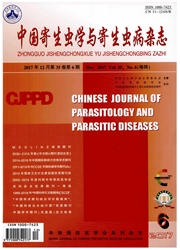

 中文摘要:
中文摘要:
目的 观察日本血吸虫(Schistosoma japonicum)感染小鼠肝脏、脾脏的病变情况及经吡喹酮治疗后小鼠外周血及脾脏中滤泡辅助性T细胞(Tfh)及其表面分子的变化。 方法 将15只6-8周龄C57BL/6雌性小鼠随机分为吡喹酮治疗感染组(治疗组)、未治疗感染组(未治疗组)和未感染组,每组5只。治疗组和未治疗组每只小鼠经腹部皮肤感染日本血吸虫尾蚴20条;治疗组小鼠于感染后6周给予200 mg/(kg·d)吡喹酮灌胃治疗,连续3 d;未感染组和未治疗组不治疗。于治疗后4周解剖各组小鼠,观察小鼠肝脏和脾脏病变情况,计算减虫率和肝脏减卵率。采用流式细胞术检测各组小鼠外周血和脾脏Tfh占CD4+ T细胞的比例,检测其表面分子可诱导T细胞共刺激分子(ICOS)和程序性死亡受体1(PD-1)的表达情况。采用ELISA检测小鼠血清中可溶性虫卵抗原(SEA)特异性IgG抗体水平。 结果 与未治疗组比较,治疗组小鼠的肝脏和脾脏病变明显较轻,减虫率和肝脏减卵率分别为84.1%和69.1%(P〈0.01)。治疗组、未治疗组和未感染组外周血和脾脏Tfh细胞的比例分别是14.7%-18.0%和15.6%-25.0%、13.7%-16.7%和12.4%-18.2%、2.5%-6.8%和4.9%-8.0%,治疗组和未治疗组明显高于未感染组(P〈0.01),治疗组和未治疗组差异无统计学意义(P〉0.05)。治疗组、未治疗组和未感染组外周血和脾脏中ICOS的表达水平分别为0.7%-1.1%和1.8%-6.8%、1.3%-3.2%和4.1%-7.0%、0.2%-0.3%和0.5%-0.8%,未治疗组高于治疗组和未感染组(P〈0.01);治疗组脾脏ICOS的表达水平明显高于未感染组(P〈0.01),而外周血的表达水平与未感染组差异无统计学意义(P〉0.05)。治疗组、未治疗组和未感染组外周血和脾脏中Tfh细胞PD-1水平分别为0.5%-1.5%和4.5%-8.9%、0.8%-1.9%和4.1%-10.7%、0.4%-0.8%和1.2%-1.8%,未治疗组明显高于未感染组(P〈0.01),治疗组与?
 英文摘要:
英文摘要:
Objective To investigate the pathological changes of liver and spleen of mice infected with Schistosoma japonicum and the changes of T follicular helper(Tfh) cells and surface molecules after praziquantel treatment. Methods Fifteen female C57BL/6 mice (6-8 weeks) were randomly assigned into the praziquantel treated infection group (treated group), infection control group(untreated group) and uninfected group (n=5 in each group). The mice in the treated group and untreated group were each infected with 20 S. japonicum cercariae through the abdominal skin, and mice in the treated group were further administered with intragastric praziquantel [200 mg/(kg·d)] at week 6 post-infection for 3 consecutive days. Mice were sacrificed at week 4 after treatment to observe the morphological changes of liver and spleen and calculate the worm reduction rate and the liver egg reduction rate. The Tfh cell to CD4+ T cell ratio, as well as the expression of inducible T-cell costimulator (ICOS) and programmed cell death protein 1(PD-1) on peripheral blood and spleen, were determined by flow cytometry. Schistosome soluble egg antigen(SEA) specific IgG antibodies in serum were detected by ELISA. Results The pathological changes of liver and spleen in the treated group were less severe compared with those of the untreated group, with a worm reduction rate of 84.1% and liver egg reduction rate of 69.1%. Flow cytometry showed that the percent of Tfh cells in peripheral blood and spleen was significantly higher in the treated group(14.7%-18.0%, 15.6%-25.0%) and the untreated group(13.7%-16.7%, 12.4%-18.2%) than that in the uninfected group(2.5%-6.8%, 4.9%-8.0%), but there was no significant difference between the treated and untreated groups. The expression of ICOS in the peripheral blood and the spleen was significantly higher in untreated group(1.3%-3.2%, 4.1%-7.0%) than in the treated group(0.7%-1.1%, 1.8%-6.8%) and the uninfected group(0.2%-0.3%, 0.5%-0.8%)(P〈0.01),
 同期刊论文项目
同期刊论文项目
 同项目期刊论文
同项目期刊论文
 期刊信息
期刊信息
